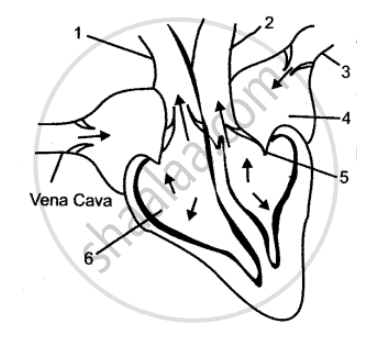Advertisements
Advertisements
प्रश्न
The diagram given below represents the human heart in one phase of its functional activities. Study the same and answer the questions that follow:
(i) Name the phase.
(ii) Label the parts 1, 2 and 3
(iii) Which part of the heart is contracting in this phase ? Give a reason to support your answer.
उत्तर
(i) Atrial systole.
(ii)
(1) Left pulmonary artery
(2) Superior vena cava
(3) Aorta.
(iii) Simultaneous contraction of both the auricles. Because the cuspid valves are open, allowing blood to flow into ventricles.
APPEARS IN
संबंधित प्रश्न
What prevents the backflow of blood inside the heart during contraction?
The human body has an organ A which acts as a double pump. The oxygenated blood coming from the lungs through blood vessel B enters the upper left chamber C of the double pump. When chamber C contracts, then blood goes into the lower left chamber D. The contraction of chamber D forces the blood to go into a blood vessel E which supplies oxygenated blood to all the organs of the body (except the lungs). The deoxygenated blood coming out of the body organs is taken by a blood vessel F to the right upper chamber G of the pumping organ. Contraction of chamber G forces the deoxygenated blood into the right lower chamber H. And finally, the contraction of chamber H sends the deoxygenated blood into the lungs through blood vessel I.
- What is organ A?
- Name the blood vessel (i) B (ii) E (iii) F, and (iv) I.
- What are chambers (i) C, and (ii) D?
- What are chambers (i) G and (ii) H?
The diagram given below represents the human heart in one phase of its activity. Study the same and then answer the question that follow:
Which part of the heart is contracting in this phase? Give a reason to support your answer.

Explain the Term
Pace maker
Give Technical Term for the following:
The phase of cardiac cycle in which the auricles contract
Identify the CORRECT statement with respect to serous pericardium.
Ligamentum arteriosum is the remnant of an embryonic duct which joins ____________.
Analogy:
Skeletal muscle: Muscle of arm.
Cardiac muscle: ______.
Why is the sino-atrial node referred to as the pacemaker of the human heart?
The rate of heartbeat is determined by ______.
